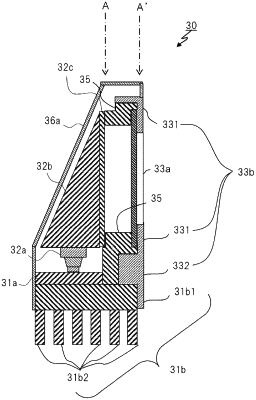| CPC G02F 1/133385 (2013.01) [G02B 27/0101 (2013.01); G02B 27/0149 (2013.01); H05K 7/20963 (2013.01); B60K 35/00 (2013.01); B60K 2370/1529 (2019.05); B60K 2370/166 (2019.05); B60K 2370/167 (2019.05); B60K 2370/23 (2019.05)] | 4 Claims |

|
1. A head up display for displaying a virtual image to a driver, the head up display comprising:
an image display device that includes a backlight, a liquid crystal panel, and a plate for holding a periphery of an emission surface, from which an image light is emitted, provided on the liquid crystal panel;
a virtual image optical system that includes a lens for transmitting the image light emitted from the liquid crystal panel, and a concave mirror for reflecting the image light to form an optical path of the image light;
a housing that accommodates the virtual image optical system; and
a heat sink that dissipates heat generated from the backlight,
the heat sink being arranged in a state where at least a portion thereof is exposed to an outside of the housing,
the plate being formed of a material having a thermal conductivity higher than that of air and provided with an emission surface exhaust heat path, and
the emission surface exhaust heat path being formed to:
include a holding region fixed to the periphery of the emission surface directly or via a material having a thermal conductivity higher than that of air, and an intermediate region connecting the holding region and the heat sink;
connect an end portion, which is opposite to the holding region, of the intermediate region with the heat sink directly or via a material having a thermal conductivity higher than that of air;
extend from the emission surface to the heat sink via the plate; and
have a thermal gradient greater than that of a heat transfer path for transferring the heat from the emission surface to the heat sink by using air as a medium.
|